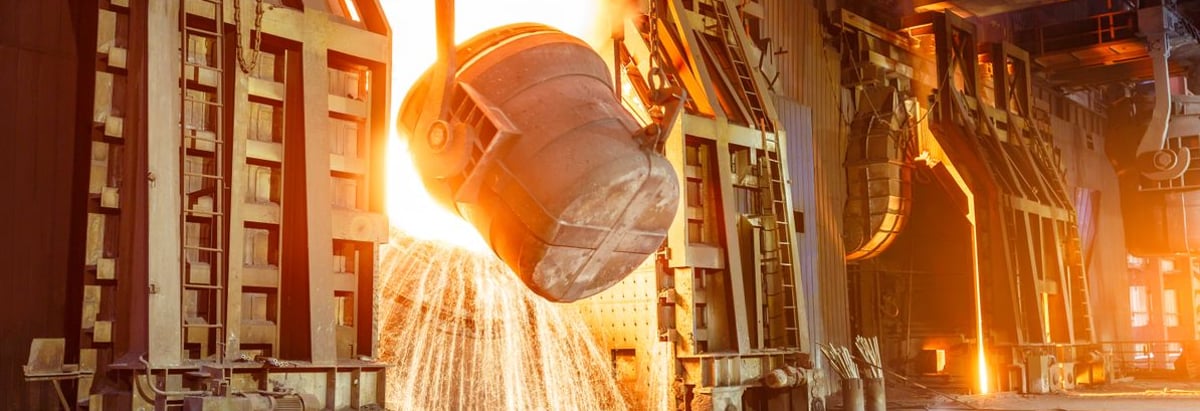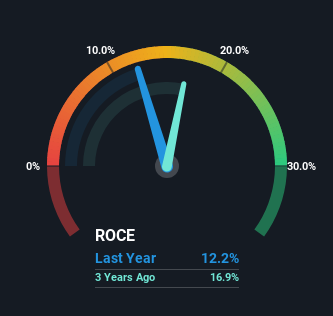- United States
- /
- Metals and Mining
- /
- NYSE:WS
Worthington Steel's (NYSE:WS) Returns On Capital Tell Us There Is Reason To Feel Uneasy

To avoid investing in a business that's in decline, there's a few financial metrics that can provide early indications of aging. More often than not, we'll see a declining return on capital employed (ROCE) and a declining amount of capital employed. Trends like this ultimately mean the business is reducing its investments and also earning less on what it has invested. Having said that, after a brief look, Worthington Steel (NYSE:WS) we aren't filled with optimism, but let's investigate further.
We've discovered 1 warning sign about Worthington Steel. View them for free.What Is Return On Capital Employed (ROCE)?
For those that aren't sure what ROCE is, it measures the amount of pre-tax profits a company can generate from the capital employed in its business. To calculate this metric for Worthington Steel, this is the formula:
Return on Capital Employed = Earnings Before Interest and Tax (EBIT) ÷ (Total Assets - Current Liabilities)
0.12 = US$156m ÷ (US$1.8b - US$521m) (Based on the trailing twelve months to February 2025).
So, Worthington Steel has an ROCE of 12%. On its own, that's a standard return, however it's much better than the 9.5% generated by the Metals and Mining industry.
View our latest analysis for Worthington Steel

Above you can see how the current ROCE for Worthington Steel compares to its prior returns on capital, but there's only so much you can tell from the past. If you'd like to see what analysts are forecasting going forward, you should check out our free analyst report for Worthington Steel .
So How Is Worthington Steel's ROCE Trending?
We are a bit worried about the trend of returns on capital at Worthington Steel. To be more specific, the ROCE was 17% three years ago, but since then it has dropped noticeably. On top of that, it's worth noting that the amount of capital employed within the business has remained relatively steady. Companies that exhibit these attributes tend to not be shrinking, but they can be mature and facing pressure on their margins from competition. So because these trends aren't typically conducive to creating a multi-bagger, we wouldn't hold our breath on Worthington Steel becoming one if things continue as they have.
The Key Takeaway
In summary, it's unfortunate that Worthington Steel is generating lower returns from the same amount of capital. Investors haven't taken kindly to these developments, since the stock has declined 12% from where it was year ago. With underlying trends that aren't great in these areas, we'd consider looking elsewhere.
If you'd like to know about the risks facing Worthington Steel, we've discovered 1 warning sign that you should be aware of.
While Worthington Steel may not currently earn the highest returns, we've compiled a list of companies that currently earn more than 25% return on equity. Check out this free list here.
Valuation is complex, but we're here to simplify it.
Discover if Worthington Steel might be undervalued or overvalued with our detailed analysis, featuring fair value estimates, potential risks, dividends, insider trades, and its financial condition.
Access Free AnalysisHave feedback on this article? Concerned about the content? Get in touch with us directly. Alternatively, email editorial-team (at) simplywallst.com.
This article by Simply Wall St is general in nature. We provide commentary based on historical data and analyst forecasts only using an unbiased methodology and our articles are not intended to be financial advice. It does not constitute a recommendation to buy or sell any stock, and does not take account of your objectives, or your financial situation. We aim to bring you long-term focused analysis driven by fundamental data. Note that our analysis may not factor in the latest price-sensitive company announcements or qualitative material. Simply Wall St has no position in any stocks mentioned.
About NYSE:WS
Undervalued with excellent balance sheet.
Similar Companies
Market Insights
Community Narratives




